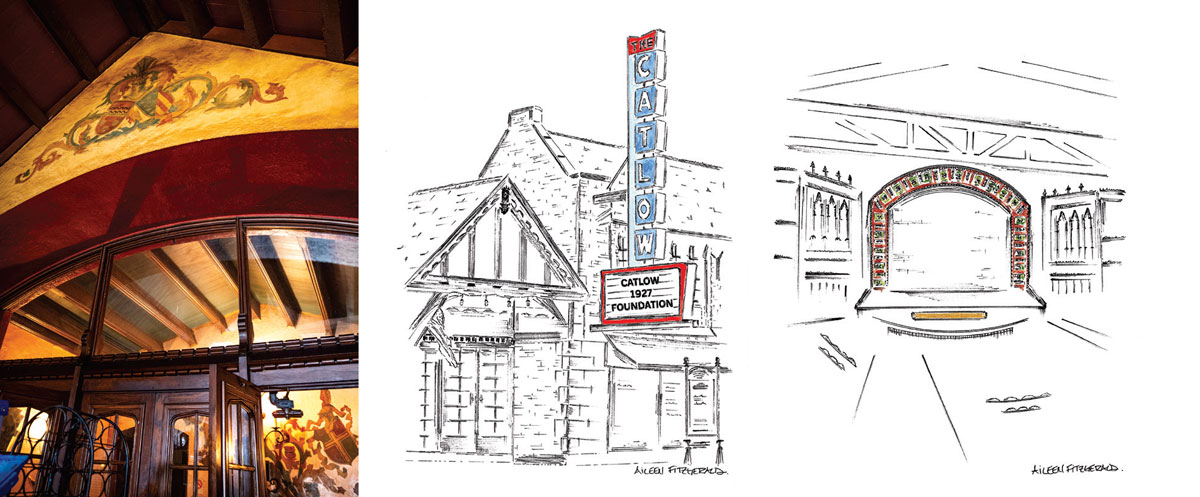

“I am so very grateful for all the folks who have supported the Catlow Theatre during the past 97 years, and I am thrilled that Julianne and Brian Long are taking on the restoration of it now.” –Diann Foley (Wright Raymond Catlow’s Granddaughter)
Several years from now, we might look back and realize that the Village of Barrington experienced a cultural Renaissance in the first decades of this century, much like that at the turn of the last century. Just over 126 years ago, the largest home, a posh Victorian, was built in the heart of Barrington. Today, the beautifully restored home, named Barrington’s White House, serves the region as a cultural center that offers enriching programs and events. Nearly 100 years ago, a local businessman, Wright Raymond Catlow, envisioned and built the Catlow Theatre, featuring a Tudor Revival exterior design by Betts & Holcomb of Chicago, an interior designed by Italian American artist Alfonso Iannelli, was built by Janesville, Wisconsin based T.S. Willis. Both properties are on the National Register of Historic Places.
Wright Catlow’s father, Joseph G. Catlow, built Barrington’s first community center, an auditorium, on West Station Street in 1916. The local newspaper headline noted that Catlow “Would Answer the Crying Need of the Village for a Public Hall.” He built a venue that could accommodate large numbers of people for dining, dancing, basketball games, and plays. Years later, when the auditorium no longer existed, his son, Wright, built the Catlow Theatre. It opened on Wright’s birthday, May 28, 1927.
The Catlow Theatre began with well-known traveling vaudeville acts, having a small orchestra pit to accommodate musicians. When Chicago was a center of country music, the Catlow was an important stop on the circuit for the National Barn Dance, a WLS Radio live show, and for other well-known musicians including Gene Autry. Vaudeville had tremendous influence on the formation of advertising, social attitudes, and mass entertainment as we know it today.
Then came the Golden Age of Hollywood. The first moving picture films, which were silent, were paired with live organ music in the theatre. Later, when talkie films arrived, and vaudeville faded away, a large, permanent movie screen was placed blocking the proscenium and the stage behind it, and live entertainment gave way to movies on film, and more recently, movies delivered digitally.
The Catlow was owned by three parties before Julianne and Brian Long
purchased the property. The theatre had been left unattended for a few years and was falling into disrepair. In what the couple believes was a miraculous moment, the closing of their purchase took place the very day the building was set to be sold for back taxes to a third-party buyer, whose intentions were unknown.
Brian Long, an alumnus of The School of the Art Institute in Chicago, owns Long & Co. Jewelers in Barrington and he and his wife, Julianne, are invested in the Barrington community. They raised their two children here, Jocelyn and Brenton, and giving back to the community has always been a priority. They saw the theatre as an essential and iconic piece of history that deserved preservation. The couple also identified with the Prairie School elements in the theatre, a topic Brian studied in school, notably the 100-year-old mission tiles on the lobby floor. The two have been collecting Prairie items for their home, such as furniture, pottery, and linens for years.
The Catlow Theatre is a place most locals can relate to. It’s where you saw your first movie. You’ll never forget your first date there. It’s the first place you were hired for a part-time job. Before you could drive, it was the first place you would walk to or ride your bike for meeting up with friends
(besides the pool, in summer). The Longs have those memories. too. Brian took Julianne on dates to the Catlow. Their son, Brenton, had his first job there selling tickets, working concessions, and making sandwiches at the former restaurant, Baloney’s. Who knows how many people have walked through the Catlow doors over a century, being inspired first by the ‘living art’ of its interior design, and then by the entertainment.
Shortly after acquiring the Catlow Theatre, the Longs realized that the undertaking to repair and restore the property to its original glory—not to mention urgent roofing repairs—would need more financial resources than they could supply on their own. They made immediate emergency repairs to exterior masonry and interior heating systems just in time to survive the first winter as the new owners. They saved historic memorabilia found that dates back to 1927.
Visit the
Catlow 1927 Foundation
To Learn More

Wright Raymond Catlow’s Great Granddaughter
“I think I was there on October 14, 2019. I don’t remember the exact day. I was in the Chicago area for a conference, and I drove up to Barrington on my last day. It was very meaningful for me to get to see a piece of my family history, especially since I never met those people. It was especially serendipitous, because the day I was there was a big community event where people were painting local landmarks. I saw many artistic renderings of the Catlow Theater and got to sit down and chat with some of the members of the historical society. I tried to buy a piece, but it was difficult to coordinate since I was leaving the state that day.”



Share this Story